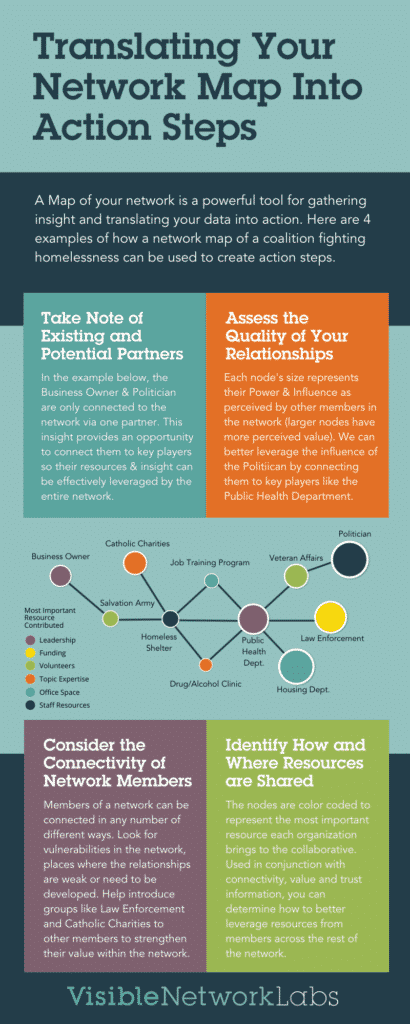How to Evaluate a Network with PARTNER
Today it’s common to use a network approach to build and leverage cross-sector partners for collaborative impact. However, very few organizations are evaluating these tactics and strategies to demonstrate their progress and find ways to improve. Collaboration in a network requires time, energy and resources that are always in short supply. If you aren’t using data to analyze how they’re being spent in relation to your goals, you may be leaving extra resources and value on the table. Here’s how to evaluate a network using PARTNER, our industry standard social network analysis tool.
Start With a Network Mindset.
Usually people jump directly into planning their evaluation instead of taking time to frame their thinking first. This is a big mistake. Networks are extremely different structures compared with traditional, hierarchical organizations many of us are familiar with. A network is defined by its interrelationships – that is, the way its members are connected to one another. These are often fluid and changing, even though the individual members remain the same over time. This is one of the unique ways we can influence a network, by making intentional decisions about how to connect partners to best reach our goals. This is the power of a network evaluation.
What Questions Are You Asking?
In most cases, we gather data for our evaluation using social network analysis surveys. This means we need to decide what information we want, and write questions that’ll gather it effectively. With PARTNER’s Eval-In-A-Box packages we’ve done this work for you already. Our 19-questions survey was created through an iterative, scientific process to identify what measures matter most for evaluating networks. Our custom metrics like value, trust, mission alignment and communication identify the information that matters most for improving cross-sector collaboration. This means you can focus more on analyzing results, instead of debating what to ask in the first place.
Bound Your Network Membership.
Traditional, hierarchical organizations usually have a pretty clear membership list. Networks are more complicated. It’s not always obvious who you should survey or include in a network evaluation (We’ve written entire blogs on the topic before). Some groups prefer letting their partners come up with and identify the network’s members, however this can complicate your results. We recommend thinking intentionally about your group membership to create a list that balances inclusion with the need for boundaries. This is often the toughest step in an evaluation, but will help provide you clarity about who exactly is your network.
Analyze Your Structure, Relationships, Attribution & Agreement.
Once your network survey is ready and your member list complete you can send out your questions and start analyzing results. PARTNER feeds all your data into our Network Analyzer in real-time, so you can start mapping results as soon as you get them. Create and explore network maps, dig into your network scores and graphs, display your collaborative on a GIS map and order complete Reports for internal and external stakeholders.
Analysis is one of the most difficult steps of an evaluation, but we help here too! Our Insights Library guides you through your data with Questions to Consider from the VNL Staff, Updates from the scientific literature, and Action Items to start crafting new strategies for the future.
How to Evaluate a Network.
In truth, the hardest part of any network evaluation is making the decision to get started. Collaboration feels like an inherently human activity to us – but many mistakenly think that means it comes to us automatically. Not so. We need to constantly evaluate the way we build and manage networks if we want to be sure we’re using our time and resources effectively. A network evaluation can arm you with the data and insight you need to do so for your organization. Now that you know how to evaluate a network, you just have to make the decision to get started – it gets easier from there on out!
About the Author: Dr. Danielle Varda
CEO, Founder, Professor, & Mother of Three Spirited Girls
Danielle is a scientist turned start-up founder, leading Visible Network Labs as CEO. Her combination of 20 years as a network scientist studying social connectedness and health, published author, 12 years as a tenured professor at the University of CO Denver, and her successful launch and scaling of the Center on Network Science came together in one big idea to start VNL. She is an entrepreneur, technologist, network scientist, fundraiser, and mother to three spirited girls. Her calling came when she realized her unique ability to develop technology solutions bridge complex systems science with everyday applications in communities, organizations, and business. She is a nationally known expert and keynote speaker on applied network science, with specific expertise in health system, public health system, entrepreneurial ecosystems, and educational system approaches. Danielle has published over 30 peer-reviewed articles on networks and their impact on health, well-being, and economic outcomes. Danielle leads VNL’s strategic partnership approach, is the company’s lead fundraiser, and has a vision for how to utilize network science to solve our most pressing and intractable problems.
In addition to her leading VNL, she is also an Associate Professor at the School of Public Affairs, University of Colorado Denver where she is Co-Director of the Center on Network Science, Director of the Nonprofit Concentration in the MPA program, and Advisor to the Dual MPA-MPH Degree. Additionally, she holds a secondary appointment in the Colorado School of Public Health, Department of Health Systems, Management, and Policy. She also has a courtesy Associate Professor appointment in the School of Information Sciences at the University of CO Boulder.






